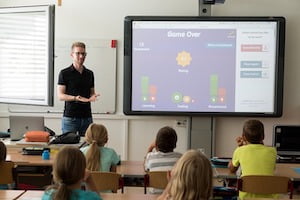The Importance of Effective ESL Instruction
Teaching English as a Second Language (ESL) is a challenging yet rewarding profession. As an ESL teacher, it is crucial to have a repertoire of effective strategies to ensure optimal learning outcomes for your students. In this article, we will explore ten proven strategies that can help you master the art of ESL teaching and create an engaging and supportive learning environment for your students.
Strategy 1: Understanding the Needs of ESL Learners
One of the first steps in mastering ESL teaching is to understand the unique needs and challenges that ESL learners face. Each student comes from a different linguistic and cultural background, and it is essential to recognize and respect these differences. Take the time to learn about your students’ native languages, as well as their cultural customs and traditions. This knowledge will not only help you tailor your instruction to their specific needs but also foster a sense of inclusivity and respect in your classroom. Additionally, be aware of the different language proficiency levels among your students and adjust your teaching strategies accordingly. Some students may be beginners, while others may have more advanced language skills. Differentiating your instruction will ensure that all students are appropriately challenged and supported in their language development journey.
Strategy 2: Creating a Positive Learning Environment
Creating a positive and supportive learning environment is crucial for ESL learners to feel comfortable and motivated to learn. Start by establishing clear expectations and rules for behavior in the classroom. This will help create a sense of structure and predictability, which is especially important for students who may be new to the educational system. Encourage open communication and respect among students, fostering a sense of community and collaboration. Celebrate diversity and create opportunities for students to share their unique experiences and perspectives. By creating a safe and inclusive space, you will not only enhance students’ language acquisition but also promote their overall well-being and self-confidence.

Strategy 3: Utilizing Authentic Materials and Resources
Using authentic materials and resources is a powerful strategy to engage ESL learners and expose them to real-life language use. Authentic materials can include newspapers, magazines, videos, podcasts, and websites that are created for native speakers of English. By incorporating these materials into your lessons, you provide students with opportunities to develop their language skills in a meaningful and relevant context. Authentic materials also expose students to different accents, dialects, and cultural nuances, helping them become more proficient and confident in their language abilities. Additionally, authentic resources can spark students’ interest and curiosity, making the learning experience more enjoyable and motivating.
Strategy 4: Incorporating Multisensory Teaching Techniques
Incorporating multisensory teaching techniques is an effective way to cater to the diverse learning styles and preferences of ESL learners. By engaging multiple senses, you can enhance students’ understanding and retention of new language concepts. For example, when teaching vocabulary, you can use visual aids, such as flashcards or pictures, to help students associate words with their meanings. Incorporating gestures and body movements can also reinforce language learning and make it more memorable. Furthermore, incorporating auditory elements, such as songs or recordings, can help students improve their listening skills and pronunciation. By appealing to different senses, you create a dynamic and interactive learning environment that accommodates the diverse needs of your students.
Strategy 5: Implementing Task-Based Learning Activities
Task-based learning activities provide ESL learners with opportunities to apply their language skills in real-life situations. Instead of focusing solely on grammar drills or vocabulary exercises, task-based learning encourages students to use language to complete meaningful tasks or projects. For example, you can design a role-playing activity where students have to act out a restaurant scenario, practicing ordering food and engaging in conversations with waitstaff. This approach not only makes learning more engaging and enjoyable but also helps students develop their communication skills and problem-solving abilities. Task-based learning activities promote active participation and collaboration among students, fostering a learner-centered approach that empowers students to take ownership of their language learning.
Strategy 6: Encouraging Active Student Participation
Encouraging active student participation is essential for ESL learners to develop their language skills and build confidence in using English. Provide ample opportunities for students to practice speaking, listening, reading, and writing in a supportive and non-judgmental environment. Incorporate pair and group work activities that require students to interact and communicate with their peers. This not only promotes language practice but also encourages students to learn from one another and develop their social skills. Additionally, encourage students to ask questions, share their opinions, and express their thoughts and ideas. By actively involving students in the learning process, you create a dynamic and engaging classroom environment that fosters language acquisition and growth.

Strategy 7: Providing Constructive Feedback and Assessment
Providing constructive feedback and assessment is crucial for ESL learners to monitor their progress and identify areas for improvement. When giving feedback, focus on specific language goals and provide clear and actionable suggestions for improvement. Be mindful of students’ individual needs and learning styles, adapting your feedback to their unique circumstances. Additionally, provide opportunities for self-assessment, allowing students to reflect on their language learning journey and set personal goals. This not only promotes learner autonomy but also helps students develop metacognitive skills, enabling them to become more effective and independent language learners. Regular assessment and feedback also allow you, as the teacher, to gauge the effectiveness of your instruction and make necessary adjustments to meet students’ needs.
Strategy 8: Fostering Language Acquisition through Immersion
Creating an immersive language environment is a powerful strategy for ESL learners to develop their language skills and fluency. Immersion involves surrounding students with English language input as much as possible, both inside and outside the classroom. Encourage students to use English in all aspects of their daily lives, from reading English books to watching English movies or TV shows. Provide opportunities for students to engage with native English speakers, such as through guest speakers or language exchange programs. Additionally, consider organizing field trips or cultural events that expose students to English language and culture in authentic settings. By immersing students in the language, you create a rich and meaningful learning experience that accelerates language acquisition and promotes cultural understanding.
Strategy 9: Integrating Technology in ESL Instruction
Integrating technology in ESL instruction can enhance students’ engagement and provide them with valuable resources for language learning. Use interactive whiteboards, tablets, or computers to present information in a visually appealing and interactive manner. Online platforms and apps offer a wide range of language learning resources, such as grammar exercises, vocabulary games, and pronunciation practice. Encourage students to use technology to explore authentic materials, such as news articles or podcasts, and engage in online discussions or language exchange platforms. Technology also allows for personalized and differentiated instruction, as students can access materials and resources at their own pace and level. By integrating technology, you create a dynamic and modern learning environment that caters to the needs and interests of digital-native learners.

Strategy 10: Collaborating with Colleagues and Parents
Collaborating with colleagues and parents is essential for effective ESL instruction. Engage in professional development opportunities, such as workshops or conferences, to stay updated on the latest research and best practices in ESL teaching. Collaborate with other teachers, both within your school and in the wider ESL community, to share ideas, resources, and strategies. This collaboration can provide valuable insights and support, helping you enhance your teaching skills and broaden your instructional repertoire. Additionally, involve parents in their child’s language learning journey by providing regular updates on progress, sharing resources for language practice at home, and inviting them to participate in classroom activities or events. By fostering collaboration, you create a network of support that benefits both you and your students.
Enhancing ESL Teaching for Optimal Results
Mastering ESL teaching requires a combination of knowledge, skills, and effective strategies. By understanding the needs of ESL learners, creating a positive learning environment, utilizing authentic materials, incorporating multisensory teaching techniques, implementing task-based learning activities, encouraging active student participation, providing constructive feedback and assessment, fostering language acquisition through immersion, integrating technology, and collaborating with colleagues and parents, you can enhance your ESL instruction and achieve optimal results. Remember that each student is unique, and it is essential to tailor your teaching strategies to their individual needs and learning styles. By continuously reflecting on your practice and seeking professional development opportunities, you can refine your skills and become a masterful ESL teacher who empowers students to achieve their language learning goals.






